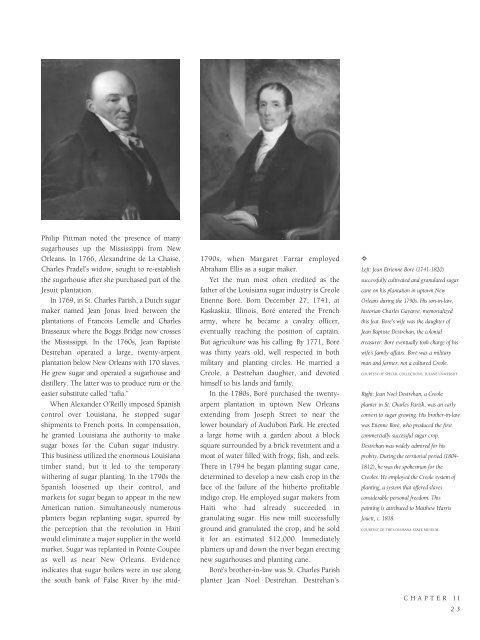Historic Louisiana
An illustrated history of Louisiana, paired with the histories of companies, families and organizations that make the state great.
An illustrated history of Louisiana, paired with the histories of companies, families and organizations that make the state great.
You also want an ePaper? Increase the reach of your titles
YUMPU automatically turns print PDFs into web optimized ePapers that Google loves.
Philip Pittman noted the presence of many<br />
sugarhouses up the Mississippi from New<br />
Orleans. In 1766, Alexandrine de La Chaise,<br />
Charles Pradel’s widow, sought to re-establish<br />
the sugarhouse after she purchased part of the<br />
Jesuit plantation.<br />
In 1769, in St. Charles Parish, a Dutch sugar<br />
maker named Jean Jonas lived between the<br />
plantations of Francois Lemelle and Charles<br />
Brasseaux where the Boggs Bridge now crosses<br />
the Mississippi. In the 1760s, Jean Baptiste<br />
Destrehan operated a large, twenty-arpent<br />
plantation below New Orleans with 170 slaves.<br />
He grew sugar and operated a sugarhouse and<br />
distillery. The latter was to produce rum or the<br />
easier substitute called “tafia.”<br />
When Alexander O’Reilly imposed Spanish<br />
control over <strong>Louisiana</strong>, he stopped sugar<br />
shipments to French ports. In compensation,<br />
he granted <strong>Louisiana</strong> the authority to make<br />
sugar boxes for the Cuban sugar industry.<br />
This business utilized the enormous <strong>Louisiana</strong><br />
timber stand, but it led to the temporary<br />
withering of sugar planting. In the 1790s the<br />
Spanish loosened up their control, and<br />
markets for sugar began to appear in the new<br />
American nation. Simultaneously numerous<br />
planters began replanting sugar, spurred by<br />
the perception that the revolution in Haiti<br />
would eliminate a major supplier in the world<br />
market. Sugar was replanted in Pointe Coupée<br />
as well as near New Orleans. Evidence<br />
indicates that sugar boilers were in use along<br />
the south bank of False River by the mid-<br />
1790s, when Margaret Farrar employed<br />
Abraham Ellis as a sugar maker.<br />
Yet the man most often credited as the<br />
father of the <strong>Louisiana</strong> sugar industry is Creole<br />
Etienne Boré. Born December 27, 1741, at<br />
Kaskaskia, Illinois, Boré entered the French<br />
army, where he became a cavalry officer,<br />
eventually reaching the position of captain.<br />
But agriculture was his calling. By 1771, Boré<br />
was thirty years old, well respected in both<br />
military and planting circles. He married a<br />
Creole, a Destrehan daughter, and devoted<br />
himself to his lands and family.<br />
In the 1780s, Boré purchased the twentyarpent<br />
plantation in uptown New Orleans<br />
extending from Joseph Street to near the<br />
lower boundary of Audubon Park. He erected<br />
a large home with a garden about a block<br />
square surrounded by a brick revetment and a<br />
moat of water filled with frogs, fish, and eels.<br />
There in 1794 he began planting sugar cane,<br />
determined to develop a new cash crop in the<br />
face of the failure of the hitherto profitable<br />
indigo crop. He employed sugar makers from<br />
Haiti who had already succeeded in<br />
granulating sugar. His new mill successfully<br />
ground and granulated the crop, and he sold<br />
it for an estimated $12,000. Immediately<br />
planters up and down the river began erecting<br />
new sugarhouses and planting cane.<br />
Boré’s brother-in-law was St. Charles Parish<br />
planter Jean Noel Destrehan. Destrehan’s<br />
✧<br />
Left: Jean Etrienne Boré (1741-1820)<br />
successfully cultivated and granulated sugar<br />
cane on his plantation in uptown New<br />
Orleans during the 1790s. His son-in-law,<br />
historian Charles Gayarre, memorialized<br />
this feat. Boré’s wife was the daughter of<br />
Jean Baptiste Destrehan, the colonial<br />
treasurer. Boré eventually took charge of his<br />
wife’s family affairs. Boré was a military<br />
man and farmer, not a cultured Creole.<br />
COURTESY OF SPECIAL COLLECTIONS, TULANE UNIVERSITY.<br />
Right: Jean Noel Destrehan, a Creole<br />
planter in St. Charles Parish, was an early<br />
convert to sugar growing. His brother-in-law<br />
was Etienne Boré, who produced the first<br />
commercially successful sugar crop.<br />
Destrehan was widely admired for his<br />
probity. During the territorial period (1804-<br />
1812), he was the spokesman for the<br />
Creoles. He employed the Creole system of<br />
planting, a system that offered slaves<br />
considerable personal freedom. This<br />
painting is attributed to Matthew Harris<br />
Jouett, c. 1818.<br />
COURTESY OF THE LOUISIANA STATE MUSEUM.<br />
CHAPTER II<br />
23
















